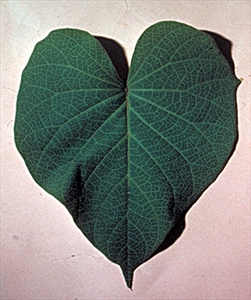Sweetpotato little leaf, sweetpotato witches' broom
Pacific Pests, Pathogens, Weeds & Pesticides - Online edition
Pacific Pests, Pathogens, Weeds & Pesticides
Sweetpotato little leaf (055)
Candidatus Phytoplasma aurantifolia
Asia, Africa (Kenya), Oceania. The phytoplasma is present in Australia, Federated States of Micronesia, Fiji, New Caledonia, Niue, Palau, Papua New Guinea, Solomon Islands, Tonga, and Vanuatu. It is recorded from Wallis & Futuna on weeds.
Sweetpotato, and probably wild Ipomoea species.
One of the first symptoms of the disease is a yellowing of the small veins, so that they are clearly seen as a network throughout the leaf (Photo 1). This is followed by the development of side shoots, which are normally dormant, giving the vines a bushy appearance (Photo 2). New leaves on these shoots become progressively smaller, until they are about an eighth the size of healthy leaves. Also, the leaves change to a light green and the shoots are generally more erect than normal.
Phytoplasmas were previously called mycoplasma-like organisms, or MLOs. They are bacteria-like, single celled organisms that only grow in the phloem cells of plants. They are spread by phloem-feeding insects. In this case, the phytoplasma is spread by the leafhopper, Orosius lotophagorum ryukyuensis (Photo 3). Phytoplasmas reproduce asexually by budding.
Leafhoppers acquire the phytoplasma when feeding on infected plants for several hours or days. After a period of approximately 20 days they are then able to transmit the phytoplasma as they feed. Once the leafhoppers have the phytoplasma in their bodies, they can transmit it until they die.
A number of wild species of Ipomoea are hosts of the phytoplasma. However, it is not known how important the Ipomoea species are in spreading the disease and causing outbreaks.
Severe outbreaks of the disease have occurred in Solomon Islands and Papua New Guinea in areas with a distinct dry season - Guadalcanal Plains, Santa Ana (Solomon Islands) and around Port Moresby (Papua New Guinea). Yield losses of 30-90% have been reported.
The disease also causes stunting of the root system, and affected plants produce few, if any, storage roots. But in both Solomon Islands and Papua New Guinea, this is not usually a serious disease. It is worse in drier times, when leafhopper populations increase. It may become more important if drier climates occur associated with climate change and more frequent El Niño events.
Look for the yellowing of the veins, which is the first symptom, then the production of many shoots with small leaves, giving the plant a characteristic bushy appearance.
CULTURAL CONTROL
Cultural control measures are important in reducing the impact of this disease.
Before planting:
- Only take planting material from gardens where the disease has not been seen. Little leaf is spread mostly in infected planting material.
- If that is not possible, carefully select cuttings from plants that are free of the disease. Look for symptoms after planting. If seen, remove and burn the plants.
During growth:
- Remove plants with signs of the disease as soon as they appear, and burn them.
After harvest:
- Collect all the vines and burn them, or dig them into the soil.
RESISTANT VARIETIES
No resistance was found among more than 200 varieties screened in Solomon Islands, although one variety, WV5, had tolerance to the disease. The Pacific Community plant genetic resources lab (CePaCT) maintains the variety in tissue culture.
CHEMICAL CONTROL
Chemical control should only be considered under exceptional circumstances. In dry times, the population of the leafhopper may rise, and the disease may reach epidemic levels. Treat crops with an insecticide, but also destroy infected plants to remove the source of the disease. Do the following:
- Use plant-derived products, such as neem, derris, pyrethrum and chilli (with the addition of soap). (For the use of neem and chilli see Fact Sheet nos. 402, 504, respectively; for derris see Fact Sheet no. 56.)
-
Use microbial insecticides, synthetic products derived from microorganisms, such as abamectin, Bt - Bacillus thuringiensis, and spinosad
- Synthetic pyrethroids are likely to be effective, but will also kill natural enemies.
--------------------
Note, derris (Derris species) contains rotenone, an insecticide, often used as a fish poison; it should be used with caution. The commercial derris insecticide is made from Derris elliptica.
____________________
When using a pesticide (or biopesticides), always wear protective clothing and follow the instructions on the product label, such as dosage, timing of application, and pre-harvest interval. Recommendations will vary with the crop and system of cultivation. Expert advice on the most appropriate pesticide to use should always be sought from local agricultural authorities.
AUTHORS Helen Tsatsia & Grahame Jackson
Information from Jackson GVH et al. (1984) Sweet potato little leaf. Advisory leaflet 19. South Pacific Commission. Noumea, New Caledonia. (https://lrd.spc.int/index.php?option=com_docman&task=cat_view&gid=276&Itemid=615&limitstart=30).
Produced with support from the Australian Centre for International Agricultural Research under project PC/2010/090: Strengthening integrated crop management research in the Pacific Islands in support of sustainable intensification of high-value crop production, implemented by the University of Queensland and the Secretariat of the Pacific Community.






